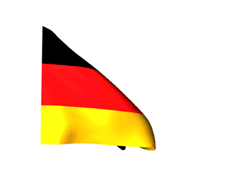 The black-red-yellow tricolor of the current German flag experienced remarkable development hand in hand with historical events. In the mid-19th century, these colors symbolized efforts to unify the German states. In 1919, the tricolor became the official flag of the Weimar Republic. However, when Hitler took the power in 1933, it was abolished and replaced by Nazi swastika. Shortly after the defeat in the World War II, the tricolor was re-adopted as the flag of modern Germany. The flag of East Germany differed a little bit by a symbol of communism in its middle. However, it was withdrawn after the unification of these two countries and the role of the national flag of the united Germany was overtaken by the flag of the German Federal Republic.
The black-red-yellow tricolor of the current German flag experienced remarkable development hand in hand with historical events. In the mid-19th century, these colors symbolized efforts to unify the German states. In 1919, the tricolor became the official flag of the Weimar Republic. However, when Hitler took the power in 1933, it was abolished and replaced by Nazi swastika. Shortly after the defeat in the World War II, the tricolor was re-adopted as the flag of modern Germany. The flag of East Germany differed a little bit by a symbol of communism in its middle. However, it was withdrawn after the unification of these two countries and the role of the national flag of the united Germany was overtaken by the flag of the German Federal Republic.
 The flag of Berlin has three stripes of red-white-red, the two outer stripes each occupying a fifth of its height, the middle the remaining three fifths. It is emblazoned with a bear on the civil flag, while it bears the coat of arms of Berlin on the state flag. The earliest city seal in existence from 1253 didn't feature a bear but an eagle, which was the symbol of the Margraviate of Brandenburg, an important principality of the Holy Roman Empire that included Berlin. Then in 1280, a second city seal appeared with the Brandenburg eagle flanked by two standing bears.
The flag of Berlin has three stripes of red-white-red, the two outer stripes each occupying a fifth of its height, the middle the remaining three fifths. It is emblazoned with a bear on the civil flag, while it bears the coat of arms of Berlin on the state flag. The earliest city seal in existence from 1253 didn't feature a bear but an eagle, which was the symbol of the Margraviate of Brandenburg, an important principality of the Holy Roman Empire that included Berlin. Then in 1280, a second city seal appeared with the Brandenburg eagle flanked by two standing bears.
To return to the main listing of the cruise hyperlinks click here
 The black-red-yellow tricolor of the current German flag experienced remarkable development hand in hand with historical events. In the mid-19th century, these colors symbolized efforts to unify the German states. In 1919, the tricolor became the official flag of the Weimar Republic. However, when Hitler took the power in 1933, it was abolished and replaced by Nazi swastika. Shortly after the defeat in the World War II, the tricolor was re-adopted as the flag of modern Germany. The flag of East Germany differed a little bit by a symbol of communism in its middle. However, it was withdrawn after the unification of these two countries and the role of the national flag of the united Germany was overtaken by the flag of the German Federal Republic.
The black-red-yellow tricolor of the current German flag experienced remarkable development hand in hand with historical events. In the mid-19th century, these colors symbolized efforts to unify the German states. In 1919, the tricolor became the official flag of the Weimar Republic. However, when Hitler took the power in 1933, it was abolished and replaced by Nazi swastika. Shortly after the defeat in the World War II, the tricolor was re-adopted as the flag of modern Germany. The flag of East Germany differed a little bit by a symbol of communism in its middle. However, it was withdrawn after the unification of these two countries and the role of the national flag of the united Germany was overtaken by the flag of the German Federal Republic. The flag of Berlin has three stripes of red-white-red, the two outer stripes each occupying a fifth of its height, the middle the remaining three fifths. It is emblazoned with a bear on the civil flag, while it bears the coat of arms of Berlin on the state flag. The earliest city seal in existence from 1253 didn't feature a bear but an eagle, which was the symbol of the Margraviate of Brandenburg, an important principality of the Holy Roman Empire that included Berlin. Then in 1280, a second city seal appeared with the Brandenburg eagle flanked by two standing bears.
The flag of Berlin has three stripes of red-white-red, the two outer stripes each occupying a fifth of its height, the middle the remaining three fifths. It is emblazoned with a bear on the civil flag, while it bears the coat of arms of Berlin on the state flag. The earliest city seal in existence from 1253 didn't feature a bear but an eagle, which was the symbol of the Margraviate of Brandenburg, an important principality of the Holy Roman Empire that included Berlin. Then in 1280, a second city seal appeared with the Brandenburg eagle flanked by two standing bears.